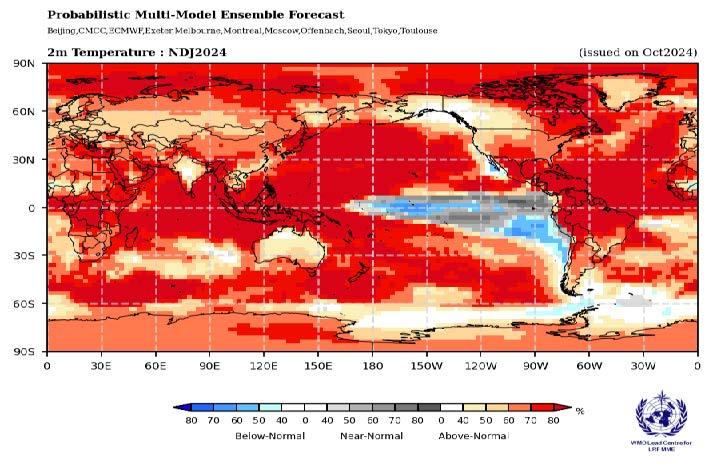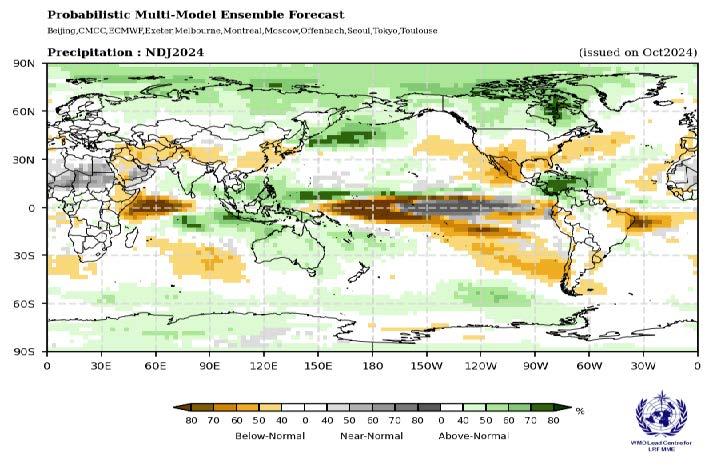Global Seasonal Climate Update for November-December-January 2024-25
During July-September 2024, in general, the observed SST anomalies in global oceans were positive. The Pacific Niño sea-surface temperature (SST) index anomaly in the eastern Pacific (Niño 1+2) was negative. Of the other three Niño indices only the Niño 4, the westernmost index, anomaly was above zero while anomalous SST conditions in the equatorial central and eastern Pacific were near-zero. Overall, the SST state in the equatorial central and eastern Pacific reflected ENSO-neutral conditions. The observed Indian Ocean Dipole (IOD) anomaly was near-zero. Both the North Tropical Atlantic (NTA) and South Tropical Atlantic (STA) SST index anomalies were above-zero and reflected widespread warmth in the tropical Atlantic.

Sea-surface temperature anomalies in the Niño 3.4 and Niño 3 regions are predicted to decline during November-January 2024-25 and are predicted to reflect weak La Niña conditions. Farther west in the Niño 4 region, the sea-surface temperature anomaly is also predicted to decline and become negative. The strength of the IOD index is predicted to be above average. In the equatorial Atlantic, SSTs are predicted to be above-normal in both the northern (NTA) and the southern (STA) regions during the season with a prediction for larger positive anomalies for NTA.


Along with the anticipated continuation of widespread above-normal sea-surface temperatures in all ocean basins outside of the near-equatorial eastern Pacific Ocean, there is prediction of above-normal temperatures over almost all land areas. A few exceptions to this widespread warmth include land areas in the vicinity of the Bering Sea and the Gulf of Alaska, Baja California, and interior western region of the Indian subcontinent. Extensive areas of large increases in probabilities for above-normal temperatures include almost the entire South America, the Caribbean, Central America, southwest and extreme northeast parts of North America, between 15°S – 10°N over Africa, parts of Arabian Peninsula, northeast region of the Indian subcontinent, the Maritime continent, New Zealand, and the Arctic regions north of 60°N. Regions with moderate to weaker increase in probabilities for above-normal temperatures include Australia, Europe, between 40° – 60°N over Asia, Greenland, and narrow belt along 15°N in Africa. In coastal areas of southern South America and extending north along the west coast to just north of the equator and into the eastern Pacific, consistent with the predicted emergence of weak La Niña, below- or near-normal temperatures are expected.
Predictions for rainfall for November-January 2024-25 are consistent with the expected impacts of La Niña. Enhanced probabilities for near- or below-normal rainfall are predicted over a narrow band along or just north and south of the equator extending eastward from 150°E to the western coast of South American. Below the equator, there is an additional band of enhanced probabilities for below-normal rainfall starting from 150°W and extending south-eastwards to reach the western coast of South America and crossing into the southern Atlantic. Enhanced probabilities for below-normal rainfall are also predicted over the northeast South America extending into the Atlantic, North America below 45°N, the Arabian Peninsula extending north-eastward into Central Asia, over the Greater Horn of Africa extending into the Indian Ocean to 90°E, and parts of eastern Asia. Enhanced probabilities for above-normal rainfall are anticipated over the region centred over the Maritime Continent extending to cover Australia and extending further into the western Pacific to 150°W, southern regions of Central America and the Caribbean, Arctic regions north of 60°N, the southern regions of the Indian subcontinent, and regions below 60°S in the Southern Hemisphere. Other regions of enhanced probabilities for above-normal rainfall include a band off the coast of eastern Asia extending north-eastward to the Bering Sea and the Gulf of Alaska.










